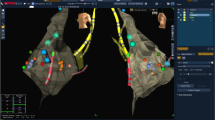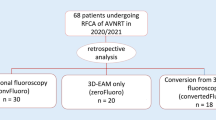Abstract
Purpose
Irrigated-tip ablation catheters increase safety and efficacy of ablation procedures, but their use in atrioventricular nodal re-entrant tachycardia (AVNRT) ablation has not been systematically evaluated. The aim of this study is to evaluate the safety and efficacy of radiofrequency (RF) catheter ablation of AVNRT by means of the novel flexible-tip open-irrigated catheter FlexAbility™ and a 3D electroanatomic mapping (EAM) system.
Methods
This is a single-center and single-operator study on 80 patients referred for AVNRT catheter ablation. Outcome included acute and long-term procedural success as well as complications reported over a median follow-up of 19 months (interquartile range 6–24 months).
Results
Acute success was achieved in all 80 patients. One procedure-related major complication, involving the vascular access, occurred. Mean fluoroscopy time was 106 ± 71 s. One patient (1.2%) suffered long-term AVNRT recurrence. Five patients (6.2%) underwent ablation for AVNRT combined with ablation for other clinical arrhythmias.
Conclusions
Irrigated RF ablation of AVNRT by means of the novel flexible-tip open-irrigated catheter associated to 3D EAM system is effective and safe. Success rates are comparable to those of other techniques. Complication rate is very low.

Similar content being viewed by others
References
Page RL, Joglar JA, Caldwell MA, Calkins H, Conti JB, Deal BJ, et al. 2015 ACC/AHA/HRS Guideline for the Management of Adult Patients with Supraventricular Tachycardia: a report of the American College of Cardiology/American Heart Association Task Force on Clinical Practice Guidelines and the Heart Rhythm Society. J Am Coll Cardiol. 2016;67(13):e27–e115. https://doi.org/10.1016/j.jacc.2015.08.856.
Brembilla-Perrot B, Houriez P, Beurrier D, Claudon O, Burger G, Vançon AC, et al. Influence of age on the electrophysiological mechanism of paroxysmal supraventricular tachycardias. Int J Cardiol. 2001;78(3):293–8. https://doi.org/10.1016/S0167-5273(01)00392-8.
Katritsis DG, Marine JE, Contreras FM, Fujii A, Latchamsetty R, Siontis KC, et al. Catheter ablation of atypical atrioventricular nodal reentrant tachycardia. Circulation. 2016;134(21):1655–63. https://doi.org/10.1161/CIRCULATIONAHA.116.024471.
Jackman WM, Beckman KJ, McClelland JH, Wang X, Friday KJ, Roman CA, et al. Treatment of supraventricular tachycardia due to atrioventricular nodal reentry by radiofrequency catheter ablation of slow-pathway conduction. N Engl J Med. 1992;327(5):313–8. https://doi.org/10.1056/NEJM199207303270504.
Calkins H, Epstein A, Packer D, Arria AM, Hummel J, Gilligan DM, et al. Catheter ablation of ventricular tachycardia in patients with structural heart disease using cooled radiofrequency energy. J Am Coll Cardiol. 2000;35(7):1905–14. https://doi.org/10.1016/S0735-1097(00)00615-X.
Katritsis DG, Zografos T, Katritsis GD, Giazitzoglou E, Vachliotis V, Paxinos G, et al. Catheter ablation vs. antiarrhythmic drug therapy in patients with symptomatic atrioventricular nodal re-entrant tachycardia: a randomized, controlled trial. Europace. 2016;(September):euw064. https://doi.org/10.1093/europace/euw064.
Chrispin J, Misra S, Marine JE, Rickard J, Barth A, Kolandaivelu A, et al. Current management and clinical outcomes for catheter ablation of atrioventricular nodal re-entrant tachycardia. EP Europace. 2017;20:1–9. https://doi.org/10.1093/europace/eux110.
Álvarez M, Tercedor L, Almansa I, Ros N, Galdeano RS, Burillo F, et al. Safety and feasibility of catheter ablation for atrioventricular nodal re-entrant tachycardia without fluoroscopic guidance. Heart Rhythm. 2009;6(12):1714–20. https://doi.org/10.1016/j.hrthm.2009.08.037.
Miyake CY, Mah DY, Atallah J, Oikle HP, Melgar ML, Alexander ME, et al. Nonfluoroscopic imaging systems reduce radiation exposure in children undergoing ablation of supraventricular tachycardia. Heart Rhythm. 2011;8(4):519–25. https://doi.org/10.1016/j.hrthm.2010.12.022.
St. Jude Medical. FlexAbility ™ ablation catheter instructions for use; n.d. https://www.cardiovascular.abbott/us/en/hcp/products/electrophysiology/flexability-irrigated-ablation-catheter.html
Winterfield JR, Jensen J, Gilbert T, Marchlinski F, Natale A, Packer D, et al. Lesion size and safety comparison between the novel flex tip on the FlexAbility ablation catheter and the solid tips on the thermo cool and thermo cool SFl. J Cardiovasc Electrophysiol. 2016;27(1):102–9. https://doi.org/10.1111/jce.12835.
Hirao K, Otomo K, Wang X, Beckman KJ, McClelland JH, Widman L, et al. Para-Hisian pacing: a new method for differentiating retrograde conduction over an accessory AV pathway from conduction over the AV node. Circulation. 1996;94(5):1027–35. https://doi.org/10.1161/01.CIR.94.5.1027.
Josephson ME. Supraventricular tachycardias. In: Clinical cardiac electrophysiology. 4th ed. Philadelphia: Lippincott Williams & Wilkins; 2008. p. 175–284.
Kerst G, Weig HJ, Weretka S, Seizer P, Hofbeck M, Gawaz M, et al. Contact force-controlled zero-fluoroscopy catheter ablation of right-sided and left atrial arrhythmia substrates. Heart Rhythm. 2012;9(5):709–14. https://doi.org/10.1016/j.hrthm.2011.12.025.
Walsh KA, Galvin J, Keaney J, Keelan E, Szeplaki G. First experience with zero-fluoroscopic ablation for supraventricular tachycardias using a novel impedance and magnetic-field-based mapping system. Clin Res Cardiol. 2018;0(0):1–8. https://doi.org/10.1007/s00392-018-1220-8.
Santangeli P, Proietti R, Di Biase L, Bai R, Natale A. Cryoablation versus radiofrequency ablation of atrioventricular nodal reentrant tachycardia. J Interv Card Electrophysiol. 2014;39(2):111–9. https://doi.org/10.1007/s10840-013-9842-2.
Brachmann J, Lewalter T, Kuck KH, Andresen D, Willems S, Spitzer SG, et al. Long-term symptom improvement and patient satisfaction following catheter ablation of supraventricular tachycardia: insights from the German ablation registry. Eur Heart J. 2017;38(17):1317–26. https://doi.org/10.1093/eurheartj/ehx101.
Dechering DG, Schleberger R, Greiser E, Dickow J, Koebe J, Frommeyer G, et al. Outcome of slow pathway modulation for atrioventricular nodal reentrant tachycardia with 50 versus 30 watts—more power, more effect? J Interv Card Electrophysiol. 2018;52:1–5. https://doi.org/10.1007/s10840-018-0360-0.
Siebels H, Sohns C, Nürnberg J, Siebels J, Langes K, Hebe J. Value of an old school approach: safety and long-term success of radiofrequency current catheter ablation of atrioventricular nodal reentrant tachycardia in children and young adolescents. J Interv Card Electrophysiol. 2018;53(2):267–77.
Van Hare GF, Javitz H, Carmelli D, Saul JP, Tanel RE, Fischbach PS, et al. Prospective assessment after pediatric cardiac ablation: demographics, medical profiles, and initial outcomes. J Cardiovasc Electrophysiol. 2004;15(7):759–70. https://doi.org/10.1046/j.1540-8167.2004.03645.x.
Kułakowski P, Piotrowski R, Stec SM, Kryński T, Iwańska B, Soszyńska M, et al. Ablation of atrioventricular nodal reentrant tachycardia: predictors of long-term success. Kardiol Pol. 2013;71(9):903–10. https://doi.org/10.5603/KP.2013.0224.
Ozcan C, Strom JB, Newell JB, Mansour MC, Ruskin JN. Incidence and predictors of atrial fibrillation and its impact on long-term survival in patients with supraventricular arrhythmias. Europace. 2014;16(10):1508–14. https://doi.org/10.1093/europace/euu129.
Author information
Authors and Affiliations
Contributions
A. Brieda: data collection, data analysis/interpretation, drafting article, critical revision of article, and approval of article. C. Balla: critical revision of article and approval of article. A. Pollastrelli: data analysis/interpretation, drafting article, critical revision of article, and approval of article. V. Smarrazzo: data collection, critical revision of article, and approval of article. F. Vitali: critical revision of article and approval of article. M. Malagù: critical revision of article and approval of article. R. Ferrari: critical revision of article and approval of article. M. Bertini: concept/design of the study, data collection, data analysis/interpretation, drafting article, critical revision of article, and approval of article.
Corresponding author
Ethics declarations
Written informed consent was obtained. The study was approved by the local ethics committee.
Conflict of interest
The authors report no relationship with industry or other relevant entities. Annalisa Pollastrelli is an employee of Abbott Medical Italy.
Additional information
Publisher’s note
Springer Nature remains neutral with regard to jurisdictional claims in published maps and institutional affiliations.
Rights and permissions
About this article
Cite this article
Bertini, M., Brieda, A., Balla, C. et al. Efficacy and safety of catheter ablation of atrioventricular nodal re-entrant tachycardia by means of flexible-tip irrigated catheters. J Interv Card Electrophysiol 58, 61–67 (2020). https://doi.org/10.1007/s10840-019-00578-z
Received:
Accepted:
Published:
Issue Date:
DOI: https://doi.org/10.1007/s10840-019-00578-z




